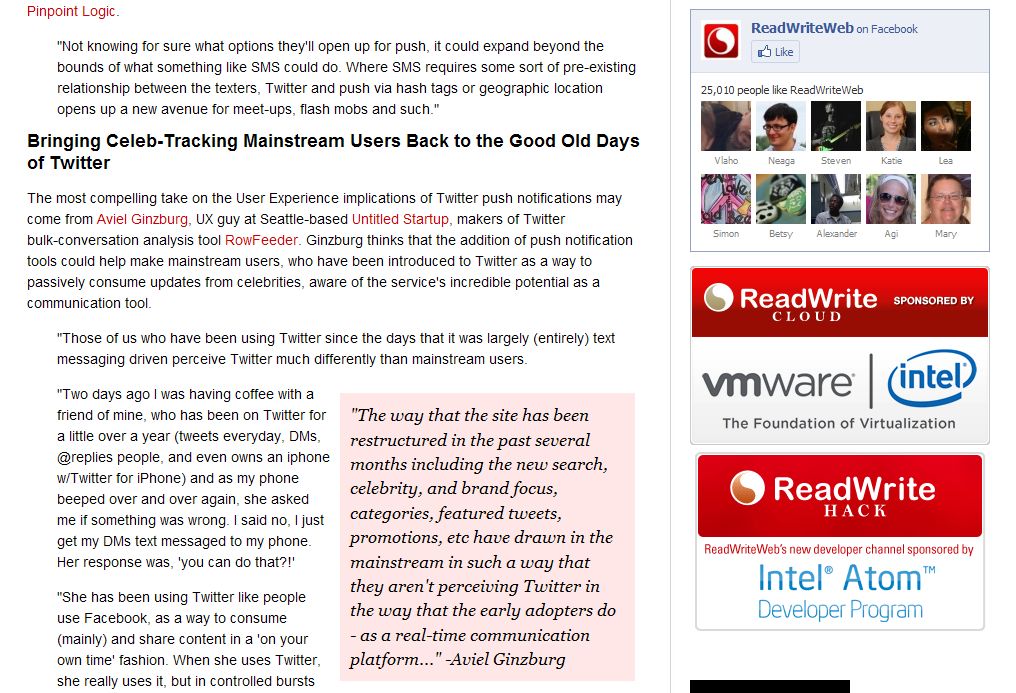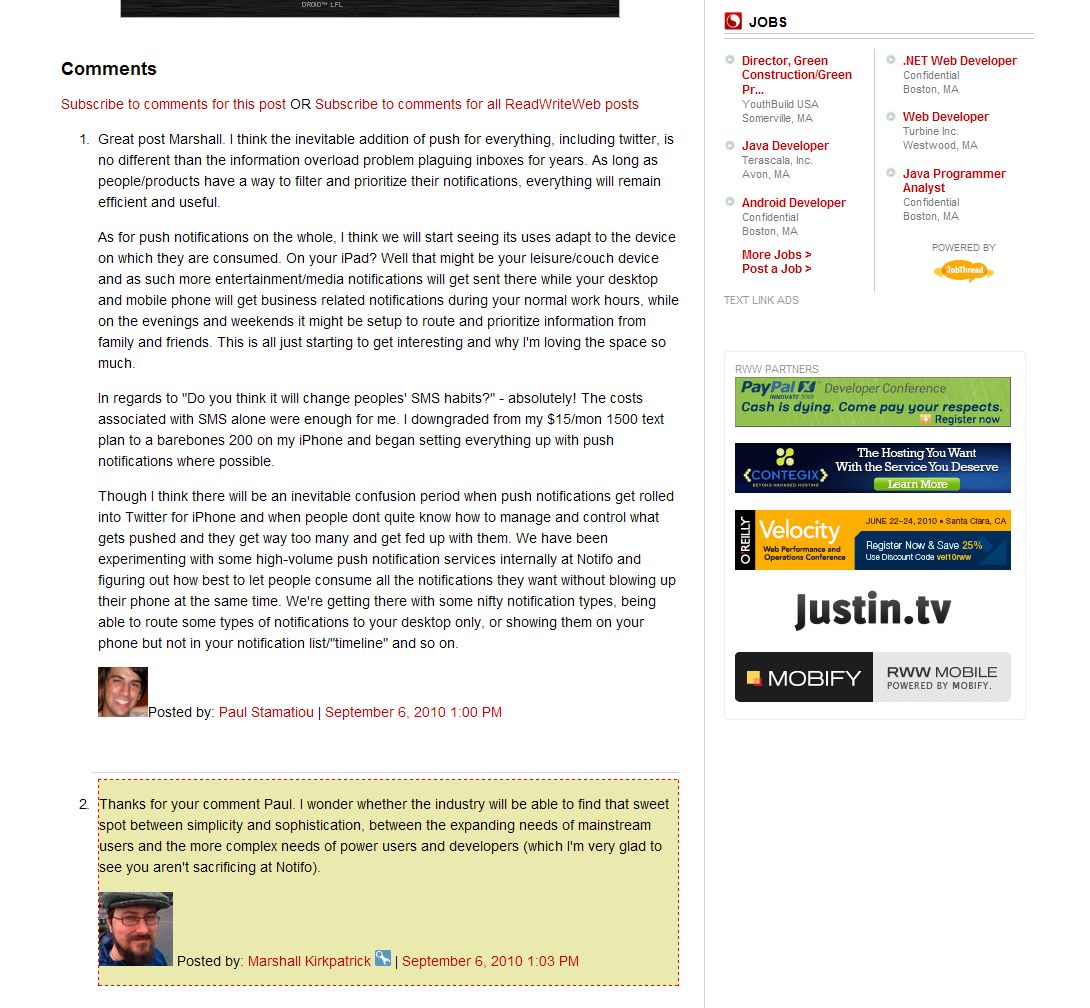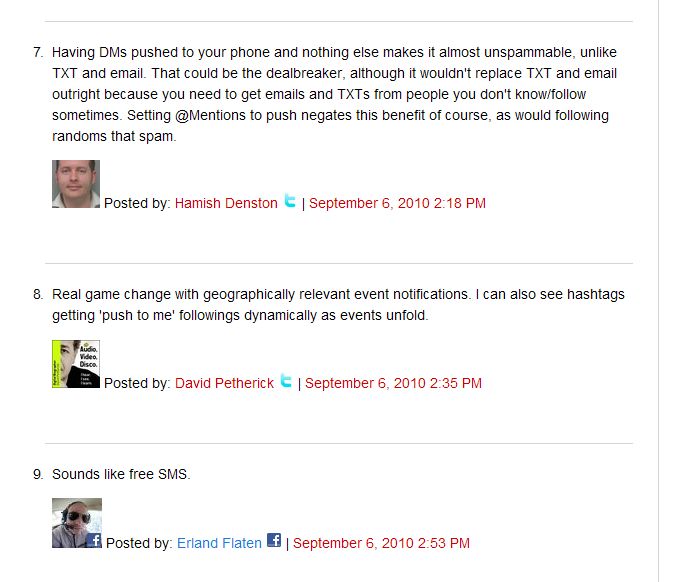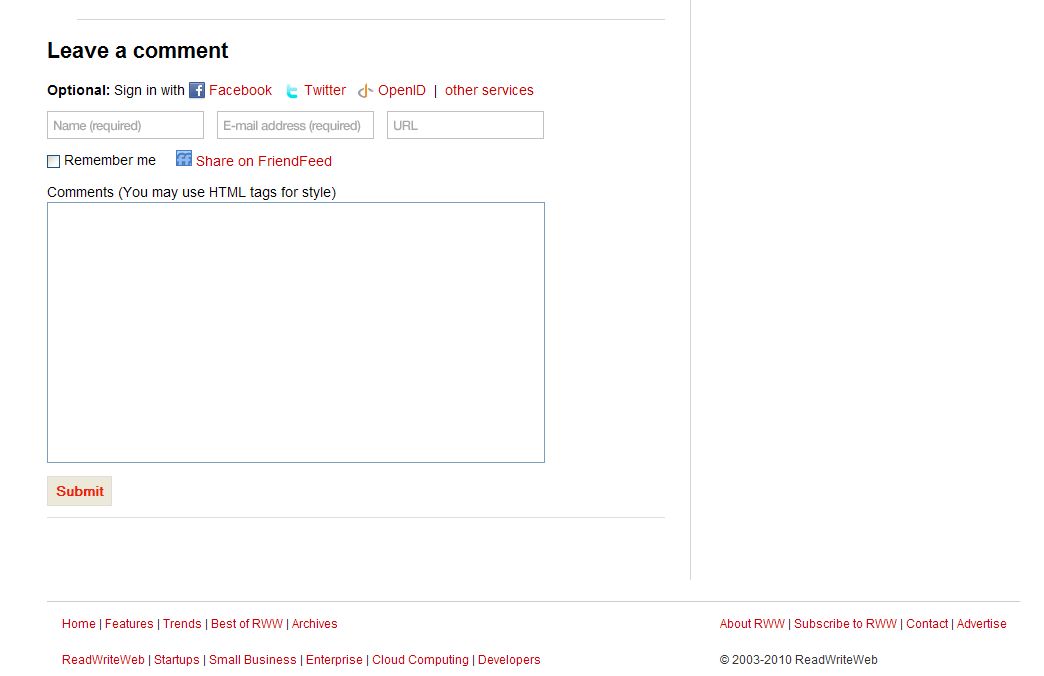ReadWriteWeb Growing Pains and Managing Bloggers
As we continue to grow ReadWriteWeb over the second half of 2010, I struggle with our inability to hire US writers full-time because it’s a non-US company. This creates unease amongst our bloggers.

Throughout 2010 we released a few more channels: ReadWriteCloud to cover cloud computing, ReadWriteBiz for small-medium business owners, and ReadWriteHack for developers. ReadWriteEnterprise (for large business) and ReadWriteStart (for entrepreneurs) continued as well. The channels were my domain as coeditor, while Marshall looked after the news operation.
We had a solid roster of writers and editors for the channels. Alex Williams managed Enterprise and Cloud, Audrey Watters was doing Start, John Paul Titlow was on Biz (we’d hired him in June, when that channel began), and Klint Finley was covering the Hack channel, which had launched at the end of August.
Our sixth channel would be ReadWriteMobile. With the Apple App Store an increasingly popular part of the internet ecosystem, and Android beginning to make inroads too, there was a lot of demand for mobile content. While we covered this anyway as part of our consumer-focused content on the main site, we’d been discussing a specialist mobile channel with FM Publishing since February. FM had relationships with several major US mobile-phone vendors, so they were confident of providing a well-paying sponsor.

The initial sponsor FM had in mind didn’t come through, but by July they were dangling Alcatel-Lucent as a potential exclusive sponsor. We were pleased to hear this, as Alcatel-Lucent had been a sponsor of our recent New York event and we had a good relationship with their point man, Mike Maney.
We pitched ReadWriteMobile as a channel “dedicated to helping its community understand the strategic business and technical implications of developing mobile applications.” This template had been successful on some of our other channels: being a resource and guide for a specific audience, rather than covering news or product reviews. By the end of August we had the sign-off to launch Mobile. It would require seven posts per week, one of which had to be a poll.

Now my attention turned to finding a writer for it. There was one obvious candidate: our current star performer for the main site, Sarah Perez. In her Twitter bio she’d written that she was “obsessed with mobile”—the proof of that, I thought, was that she was just as passionate about covering the up-and-coming Android as she was writing about the more mainstream iPhone. Sarah was writing ten posts per week on RWW, so the additional seven for the new channel would allow us to bring her on full-time. At this point she was still doing blogging work for Microsoft as well.
I emailed Sarah near the end of August to make the proposal. She was enthusiastic in her reply but wanted a bit more money than we’d offered—and she also requested a small equity stake in RWW. Sarah wasn’t the first to broach equity; Frederic had also asked about it when we were discussing his coming on board full-time earlier in the year. It wasn’t as if we couldn’t come up with an equity structure for the writers, even though we were an NZ company. After all, both Sean and Marshall had small equity stakes already. But this would mean diluting the equity stakes of the current shareholders.

I discussed it with Sean over email. He suggested that we could set up an option pool and allocate options to key staff members from that pool. However, he also hinted that he didn’t want his own equity stake to be diluted. “I took a significant pay cut to take this job and have not entertained any incoming emails from recruiters over the last six months,” he wrote. “This is primarily because I really enjoy this job and place a high value on honoring commitments, but also because I hope the equity makes the salary closer to competitive in the long term.”
The implication was clear. If I was to give Sarah and our other full-timers an equity stake—because it would be unfair to offer it to Sarah and not to our five other full-time people—it would have to come from my own personal stake. Unfortunately, I was still trying to negotiate a financial settlement with my ex-wife (and had been for well over a year). I was reluctant to dilute the equity from my stake because I would almost certainly have to bear the cost of it by myself—my ex-wife’s lawyer would see to that. I wasn’t willing to entertain the thought of my ex ending up with a larger stake in RWW than I held.

This was all part of a larger issue I’d been grappling with for some time now: how to incentivize our full-time staff, given the restrictions inherent in our company structure. The problem remained that RWW was an NZ company and not a US one. Due to double taxation and other legal complications, we couldn’t hire our people as full-time employees, which meant we couldn’t offer health insurance and all the other benefits that our US-based competitors could. Over the past several years, I had spent a lot of money on lawyers and accountants—from both New Zealand and America—trying to come up with a legal structure that would fix this. But the answer was always the same: since I didn’t live in the States, I couldn’t create a Delaware corporation like most startups did. We were stuck in a no-man’s-land of having all our full-time people on a rolling independent-contractor deal. It was deeply unsatisfactory, to both me and my staff, but I couldn’t seem to find a way out of this muddle.
I went back to Sarah with an increased pay offer but told her we couldn’t give her equity at this time. She was happy about the pay raise, though, and promptly accepted our offer. We were thrilled to bring her on board full-time, as she had consistently been our highest-performing writer all year—she was even getting higher page views than myself and Marshall.

We launched ReadWriteMobile near the end of September. With that sorted, I was able to turn my attention back to the Frederic situation. He was posting regularly on RWW again, although he wasn’t among our top performers by page views. But I’d recently noticed he had launched his own tech blog, NewsGrange. This site included a section called Aggregator with the words “our competitors” listed beneath it on the menu. Sure enough, at the top of that page was our RSS feed. So he’d started a tech blog to compete with RWW? I was confused about this, but Marshall thought it was just another side blog project—which I agreed was common in our industry (I often had a side blog on the go myself).
Of course, since Frederic wasn’t yet full-time with RWW, he could do what he wanted from a side-project point of view. I wasn’t concerned about that. What did bug me, though, was that he wasn’t replying to my emails—including when I once again reached out about a full-time role in November. We now had budget for two more full-time hires, and I still wanted to offer one of these roles to Frederic, given how long he’d been with us and his obvious talent as a tech blogger.
After November 19, things got even stranger. Frederic abruptly stopped posting on RWW, and I didn’t know why. I found out later that he had taken some holiday time and traveled to the Le Web conference in Paris, which ran December 8 to 9 that year. He posted a few articles from there but still wasn’t communicating with me. He didn’t post again after Le Web and ignored all our emails about a year-end post he’d been assigned (we reassigned it to Sarah).

As all this was going on, Marshall floated the idea of hiring Mike Melanson for one of the available full-time roles. “Frederic has long been drifting slowly away,” he wrote to me in early December, “and Mike has been working hard to be a full-time member of the team.”
So we ended up hiring Mike and Audrey Watters to full-time writer roles. Eventually, Frederic sent the email he’d probably been sitting on for a month or two, subject line: “time to say goodbye.” It was a polite email, and we all understood that he wanted to move on to new adventures. However, he did bring up the lack of equity for full-time people as one of his reasons for leaving.
Marshall informed the team, noting, “Frederic has been with us longer than anyone but Richard (obviously), myself and Sarah.” It was true: he had been with us for two and a half years, so it was sad to lose him. I also didn’t like seeing a writer we had developed in-house walk out the door, possibly into the arms of one of our competitors, rather than take the next step with us.
Naturally, I wondered if things would’ve turned out different with Frederic had RWW been a US company. I was now starting to worry about our ability to hang on to key writing talent.

This post is part of my serialized book, Bubble Blog: From Outsider to Insider in Silicon Valley's Web 2.0 Revolution. View table of contents.
Next up: 056. Swapping Web 2.0 Summit for PARC; and RWW Planning for 2011
Buy the Book
My Web 2.0 memoir, Bubble Blog: From Outsider to Insider in Silicon Valley's Web 2.0 Revolution, is now available to purchase:
- Paperback, US$19.99: Amazon; Bookshop.org
- eBook, US$9.99: Amazon Kindle Store; Apple Books; Google Play
Or search for "Bubble Blog MacManus" on your local online bookstore.